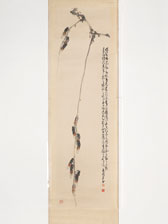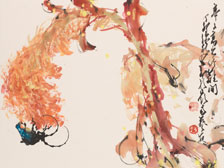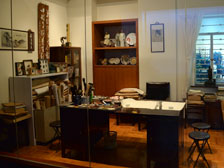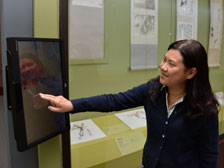
Dew diligence:
Chao’s 1970 work “Cicadas” features his favourite insect, a symbol of purity and virtue in Chinese culture.

Centre of attention:
Chao methodically composed his works to draw the viewers’ eye towards flowers or insects.

Master of nuance:
Chao had insect specimens in his studio to help him become more intimately acquainted with his subjects - down to their every minute detail.

High definition:
Magnified onscreen photos reveal there is much more to Chao’s engaging paintings than immediately meets the eye.
Exhibit goers revel in the details
November 24, 2013
There is so much more to Chao Shao-an’s engaging paintings than immediately meets the eye. For an exhibition that showcases 40 works from the naturalist-perfectionist, the Hong Kong Heritage Museum has installed electronic screens that magnify them, so viewers can revel in the artist’s delightful, delicate details.
“Sounds in the Grass: Selected Works of Insects by Chao Shao-an”, gives visitors an eyeful of insight into the Lingnan school of painting’s naturalistic tradition, of which the artist was a master. It also presents truly natural reflections of flowers and the insects they attract.
Virtuous cicada
On a tour of the works with
news.gov.hk, museum Assistant Curator Rose Lee described Chao’s fascination with the cicada, a large bug with a broad head and transparent wings, and, in males, the ability to make a shrill droning noise by rubbing together membranes on its abdomen. The insect is a recurring subject in Chao’s works that features prominently in this exhibition.
“The cicada was traditionally a symbol of purity and virtue in Chinese culture, because the ancient people saw the cicadas sitting up in the tree, they were singing very loudly, but they never eat anything. So the ancient people believed that they only drink the dew, which is very pure, and they regarded the cicada as a virtuous creature,” she said.
Poets and painters alike agreed with this line of thinking. Chao himself closely identified with the cicada: He named his studio the Hall of Radiant Cicada, and produced a 20-work volume called
The Radiant Cicada.
Up close and personal
To become more intimately acquainted with his subjects down to their every minute detail, Chao placed insect specimens in his studio and studied them closely. His superb control and mastery of ink and brushstroke is particularly seen in his painting of cicadas.
“The cicada has a very hard back. Prof Chao would use a very rich ink so the back is very dark and shiny, and he would put a dot of white on top, so this is the highlight spot to show that the shell is so hard, it can reflect the light,” Ms Lee explained.
Looking at a magnified high resolution photograph of one of his works on an electronic screen in the exhibition hall, she pinpoints the essence of his craft.
“To depict the transparent wings, he used a very fine brush tip to work on the outline and vein of the wings.”
Attention seeking
Many of Chao’s works were done in small formats, and methodically composed to direct the viewers’ attention towards flowers or insects.
“Sometimes, he would make use of a void in the middle of the picture. So the plant or the flower will go round in a circle, and our eyes will travel round, look at the flower and find the insect may be hanging down underneath the branch. He makes sure there is a lot of variation in the picture,” Ms Lee said.
The exhibition is being held until February 23, 2015. For details, visit the Hong Kong Heritage Museum’s
website, or call 2180 8188.